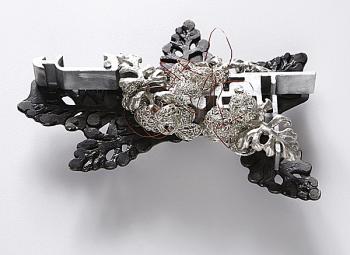
Susan Cummins: Can you tell me the story of how you discovered that you wanted to be a jeweler?
Mari Ishikawa: I worked as an interior designer in Japan. It was quite interesting, but the range was too limited. Jewelry gives me more artistic freedom. At the same time, the relationship that exists between the object, the person who wears it, and me is more personal and more intense in jewelry.

Susan Cummins: Can you tell me the story of how you discovered that you wanted to be a jeweler?
Mari Ishikawa: I worked as an interior designer in Japan. It was quite interesting, but the range was too limited. Jewelry gives me more artistic freedom. At the same time, the relationship that exists between the object, the person who wears it, and me is more personal and more intense in jewelry.
The most interesting thing for me is that jewelry writes its own story. While I am making jewelry, the piece is still my own work and connected with my story. But once someone wears the piece, a new story and relationship starts between the new owner and the jewelry. This has fascinated me about jewelry from the beginning.
After your education at the Hiko Mizuno College of Jewelry in Japan, why did you go to Munich to study?
Mari Ishikawa: In Japan, I learned the basic techniques. During my studies there, Professor Otto Künzli gave a workshop at Hiko Mizuno College. The workshop only lasted one week, but it fundamentally transformed my understanding of jewelry. Surely, the Japanese culture was formative for me, but I developed my concepts and the contents of my work in Germany. No approach depended on the country. I learned to improve my techniques and philosophy.

Mari Ishikawa: I am still living in Munich.
What is keeping you in Munich?
Mari Ishikawa: Growing up and receiving my education in Japan, I was naturally formed by the Japanese culture and lifestyle. There are plenty of things from Japan that contribute to my nature. I’m not exactly sure which thing it is, but something makes me want to see my native country from a distance. It offers a new perspective of particular importance for me. In Europe, I found out that my life belongs to me, and I started to enjoy it.
Your jewelry often makes reference to nature. Can you tell me about your desire to work with natural forms?
Mari Ishikawa: I started being attracted to flowers and weeds. Their various shapes and perfection was surprising. They are just there. I felt that their existence tells more than a thousand words sometimes. I try to freeze the plants’ beauty and stop the process of fading by keeping their essence and their memories.
As a culture, Japan seems inspired by nature. How does your concept of nature compare to that of the Germans?
Mari Ishikawa: In Japan, the relationship with nature was always vast, but I found the connection to nature much easier in Germany. I have integrated nature as a component in my work only since I began living in Munich.
Jewelers throughout the ages have used nature as inspiration. What is unusual about how you use it?
Mari Ishikawa: Images of plants are usually shown in the time between sprouting and the climax of blooming. What I’m trying to freeze is the beauty of their full life cycle.
Your show Landscape at Klimt02 Gallery incorporates references to buildings as well as landscape, so there is a hard scape and a soft scape. Is this the first time the hard scape of buildings has shown up in your work?
Mari Ishikawa: Yes. I haven’t used manmade subjects before. Recently, I was inspired by ancient gardens. The time is frozen, but the plants are just there. I would like to show the silent revolution of plants. Before man built cities, there was just nature, which we tried to control. As soon as we stop regulating nature, it tries to reclaim its native characteristics.

You have often used the color red in your work. Does this color have a special meaning for you?
Mari Ishikawa: Among traditional Japanese colors, I think red is very unique. Japan does not have vivid natural colors as compared to tropical countries. It might be because of Japan’s humid climate. However, when red is used, its tone is very strong and vivid. There is a Japanese proverb: “Two people with a close relationship are connected by a red thread on their little fingers.”
Red is symbolic of the color of sun, of fire, or a holy Shinto shrine, and at the same time, it is the color of an evil poisonous spirit. It is a powerful color that gives different impressions depending on the situation. The profundity of the red color attracts me.
Can you recommend your favorite jewelry book?
Mari Ishikawa: Otto Künzli: Das Buch
Thank you.




